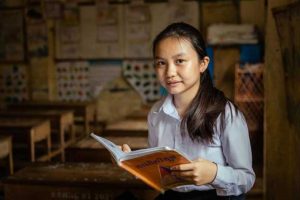
Credit: UNICEF/UN0658410/But
By Robert Jenkins
NEW YORK, Apr 6 2023 – With schools now reopened around the world, countries are called to take transformative action on education financing to recover and accelerate learning for all children, especially the poorest and most marginalized.
Findings from our recent study, however, reveal that we have yet to overcome hurdles to equitable education financing: in far too many countries, the poorest children often benefit the least from public education funding.
To transform education for every child, governments must address all three aspects of education financing: adequacy, efficiency, and equity. Our analysis covering 102 countries zeroed in on the equity challenge in education.
Many dimensions of equity are important to address, as vulnerable children can face simultaneous disadvantages related to poverty, disability, gender, location and more.
However, our study focuses on the poorest children, often hit the hardest by multiple, compounding barriers to quality education and learning.
Unfortunately, children from the poorest households often benefit the least from public education spending. On average, the poorest learners receive only 16 per cent of public funding for education, while the richest learners receive 28 per cent.
In 1 out of every 10 countries, learners from the richest 20 per cent of households receive four or more times the amount of public education spending than the poorest.
In Guinea, Mali and Chad, the richest learners benefit from over six times the amount of public education spending compared to the poorest learners.
Moreover, despite repeated commitments towards equitable financing – including the Incheon Declaration adopted at the World Education Forum 2015, the Paris Declaration of the 2021 Global Education Meeting, and most recently at the Transforming Education Summit in 2022 – data suggests that progress in delivering on these promises has been far too slow.
Evidence from 46 countries indicates that public education spending has become more inequitable in 4 out of every 10 countries. The data speaks for itself: the poorest learners are not receiving their fair share of public education funding, and we must intensify efforts to address these inequities.
Equitable education spending is critical and can reverse the effects of the global learning crisis before an entire generation loses its future. Our analysis shows that if public education spending stagnates, a one percentage point increase in the allocation of public education resources to the poorest 20 per cent is associated with a 2.6 to 4.7 percentage point reduction in learning poverty rates – translating to up to 35 million primary school-aged children that could be pulled out of learning poverty.
How can we address the equity challenge and ensure education funding reaches the poorest? One way is to ensure public funding prioritises lower education levels.
This financing principle refers to ‘progressive universalism’, by which resource allocation initially prioritises lower levels of education, where poor and marginalized children tend to be more represented. These first few years of learning lay the groundwork for children to acquire basic foundational skills. Then, when coverage at lower levels is near universal, resource allocation is gradually increased to higher levels, with a continued focus on the poorest and most marginalized.
Finally, it is important to note that inequity issues exist not only in domestic education financing, but also in international aid to education.
For instance, over the past decade, official development assistance (ODA) to education allocated to the least developed countries (LDCs) has never exceeded 30 per cent, far from the 50 per cent benchmark set forth by the Addis Ababa Action Agenda.
Moreover, appeals for education in emergencies often receive just 10 to 30 per cent of the amounts needed, with significant disparities across countries and regions. On average, the education sector receives less than 3 per cent of humanitarian aid.
The global community must come together to ensure that children living in the poorest countries and in emergencies can benefit from equitable education financing.
To respond to the equity challenge in education, we call on governments and key stakeholders to take the following key actions:
- • Most critically, unlock pro-equity public financing to education through broader coverage and volume of decentralized allocations, resources to schools, resources to students of disadvantaged backgrounds (by education and social protection ministries), and strengthened resource allocation monitoring.
• Prioritize public funding to foundational learning by securing funding for all in pre-primary and primary education and targeting the poor and marginalized at higher levels of education.
• Monitor and ensure equitable education aid allocation in developmental and humanitarian contexts between and within countries, including sub-sector levels, when applicable.
• Invest in innovative ways of delivering education to complement gaps in existing public funding through multiple and flexible pathways, including quality digital learning.
We cannot hope to end the learning crisis if we invest the least in children who need it the most.
We must act now to ensure education resources reach all learners and progress towards achieving the goal of inclusive and quality education for all – allowing every child and young person a fair chance to succeed.
Source: UNICEF Blog
The UNICEF Blog promotes children’s rights and well-being, and ideas about ways to improve their lives and the lives of their families. It brings insights and opinions from the world’s leading child rights experts and accounts from UNICEF’s staff on the ground in more than 190 countries and territories. The opinions expressed on the UNICEF Blog are those of the author(s) and may not necessarily reflect UNICEF’s official position.
IPS UN Bureau